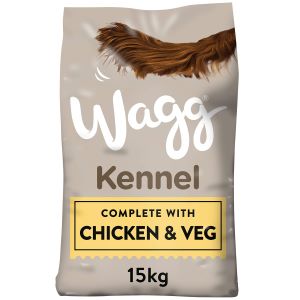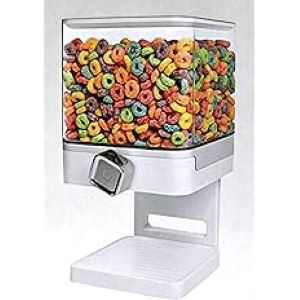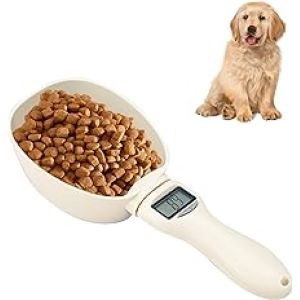Dry food, also known as kibble, is a type of dog food that consists of small, crunchy pellets that are made from various ingredients, such as meat, grains, vegetables, and vitamins. Dry food is a popular choice among dog owners, as it is convenient, affordable, and easy to store and measure.
However, dry food is not suitable for every dog, and it should be adjusted according to the dog’s age, size, weight and health condition. Dry food has some benefits and drawbacks for dogs, and it can be enhanced with other foods to make it more appealing and nutritious.
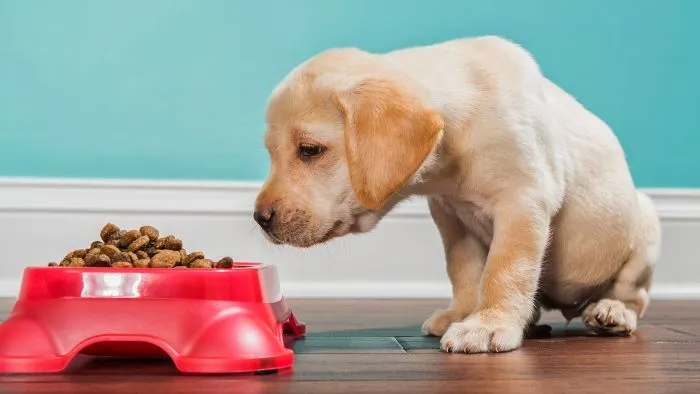
Key Takeaways
- Dry food is a convenient and affordable option for feeding dogs, but it should be tailored to the dog’s age, size, weight and health condition.
- Dry food can provide balanced nutrition, dental benefits, and longer shelf life, but it can also cause dehydration, allergies, and boredom in dogs.
- Dry food can be mixed with wet food, water, or human foods to add variety, moisture, and flavour to the dog’s diet, but it should be done with caution and moderation.
You Might Also Like:
How Much Dry Food Should You Feed a Dog?
Deciding the amount of dry food for your furry companion is a difficult task. It totally depends on the age, size, weight and other health concerns of your dog. In most cases, this method is more of a type of trial and error as no two dogs have the same nutritional requirements.
You should first try checking the dog feeding chart on the food package. It can help you determine the daily food amount you should be feeding. The average dry food allowance for an adult dog ranges from 200 to 900 grams per day.
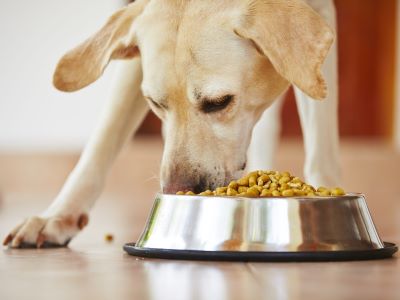
The table below provides a general recommendation and the amount may vary depending upon the need of your dog.
| Adult Dog Size (lbs.) | Dry Food Feeding Amount (Cups) |
| 3 to 12 | 1/3 to 1 |
| 13 to 20 | 1 to 1-1/3 |
| 21 to 35 | 1-1/3 to 2 |
| 26 to 50 | 2 to 2-2/3 |
| 51 to 75 | 2-2/3 to 3-1/3 |
| 76 to 100 | 3-1/3 to 4-1/4 |
| 100+ | 4-1/4 plus 1/4 cup for every 10 lbs. of body weight over 100 lbs. |
In terms of dry dog food, one cup of dog food would refer to 8 oz (8 ounces) of dog food. 1 ounce contains 28.35 grams, which means, 1 cup would contain 8 x 28.35 = 226.8 grams.
Remember, this is just a general recommendation. For a beginner, you can try giving the kibbles as per this table and observe your dog. If he overeats or feels hungry, you can accordingly decrease or increase the amount. If you feed only dry kibbles to your dog, make sure they drink enough water to compensate for the lack of moisture in the dry food.
However, some dogs can be picky about dry food or refuse to eat it. If you are wondering how to get my dog to eat dry food, there are some tips that may help.
Knowing Your Dog’s Body
It is crucial to know the requirements of your pup by figuring out its body condition. A body score chart can efficiently check and see if your dog is average, overweight or underweight. Thus, this chart will help you determine if your dog needs to gain, lose or maintain his weight.
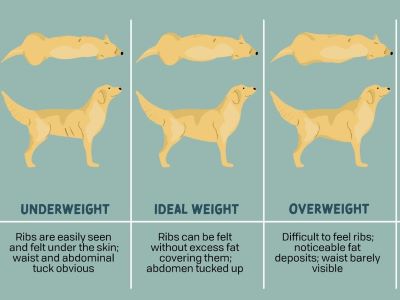
Just as we humans calculate BMI to check the ideal weight and height, pets have BCS(Body Condition Score) to evaluate their body fat. Once the body condition of your dog is known, weigh your dog to keep track of his progress. This will help in customizing the perfect diet plan for your pet.
Why Choose Dry Food?
Dry food is the most popular option among pet parents as it is pocket-friendly and convenient. kibble is much easier to travel and store. It does not get spoiled when left out as opposed to wet food. Also, it does not get messy while eating and hence the same bowl can be used again to feed your canine friend.
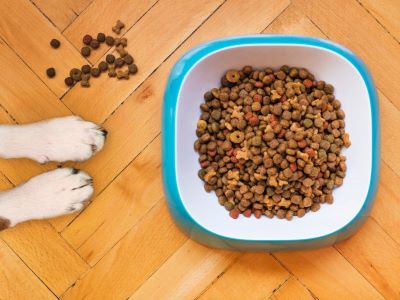
Kibbles are nutrient and calories-dense as compared to wet food. They are loaded with protein and carbohydrates which is important for your pet’s daily energy dosage. Along with physical muscle gain, kibbles help maintain dental hygiene. When dogs chew, the sharp edges can act as an oral aid to help reduce the build-up of plaque and cavities, resulting in better breath and healthier gums.
You can also soak dry kibbles to soften them. This can be helpful to senior dogs having tooth problems or a puppy that is whining. You can also soak the kibbles in warm water to give that meaty smell to temptate the dog.
Additional Tips
Divide the meal into 2-3 portions, rather than feeding in just one go. This will help decrease unscheduled food intake, enabling the consistency of meals.[1] Also, it will help the dog’s appetite follow a perfect routine and avoid the practice of free-feed. Puppies should be fed more often, dividing the daily portion into 3 to 6 meals. Senior dogs should be fed a little less than adult dogs due to their decreased activities and rate of digestion.
Kibbles are high in nutritional value, which means it has a lot of calories in just a small bowl. Thus, it is important to feed only the required amount. As per Ohio State University, feeding kibbles more than necessary can result in an upset stomach and may eventually lead to obesity. Hence, feeding quality with quantity has become a great concern. According to the Association for Pet Obesity Prevention, in 2022 about 59 percent of dogs in the United States were overweight or obese.
If you got a dog who hates eating the same food every day, you can also add other alternatives to dry food other than just kibbles.[2] This will provide a wide variety to your dog and make him enjoy the meal, rather than being bored by the same kibble taste.
If your dog prefers a plant-based diet or you want to feed vegan, be sure to choose best vegan dog food UK certified by the Vegan Society.
Mixing the Dry With Wet Food
Some dogs don’t prefer eating just dry. For them, a mixture of both dry and wet food works perfectly. Because of wet food’s consistency and smell, wet dog food is more palatable for dogs. Wet dog food contains more water, making it more hydrating than kibble.
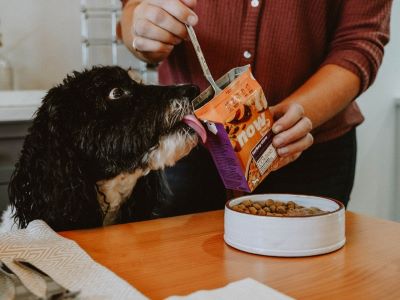
Moreover, adding a small amount of wet food to the regular kibble can enhance the taste, providing a new variety for your dog. Moreover, it satisfies the watery needs of the dog. Generally, vets suggest mixing a small amount of wet food when switching to dry food. It would be a good practice to slowly introduce the dog to kibbles.
In addition to that, dogs who are picky eaters can benefit the most from this mixture as it will guarantee a variety of tasty flavours. Wet food appeals to dogs’ senses, so mixing is an effective way to lure them to finish their dry food. Also, senior dogs will be able to chew their meal easily because of the softened texture.
Moreover, adding a small amount of wet food or human foods like marmite to the regular kibble can enhance the taste, providing a new variety for your dog. However, be sure to research on can dogs eat marmite before feeding it to your pet
FAQs
How many grams of dry dog food per cup?
In terms of dry dog food, one cup of dog food would refer to 8 oz (8 ounces) of dog food. 1 ounce contains 28.35 grams, therefore 1 cup would contain 226.8 grams.
How much dry food to feed a dog?
Assuming your dog has a typical activity level, toy breeds should have about ¼ cups to 1 cup, small breeds should have about 1 cup to 1-2/5 cups, medium breeds should have about 2 cups to 2-2/3 cups, and large breeds should have about 2-4/5 cups to 3 cups. However, Senior dogs should be fed a little less than adult dogs.
Is too much dry food bad for dogs?
A dog’s stomach is designed to digest proteins, fats, carbohydrates and fluids. Dry food contains low amounts of carbohydrates, proteins, and fats and is often fortified with vitamins and minerals. Hence, an excess of dry dog food can harm your dog’s health as it will not provide the nutrients they need.
Is dry food enough for dogs?
Many pet parents choose to feed their pet only dry kibbles, which is perfectly fine provided they drink enough water to compensate for the lack of moisture in the dry food. From a convenience perspective, dry kibble is definitely a winner.
Summary
To conclude, no two dogs are the same and how much dry food to feed a dog depends on your furry friend. Hence, as a pet parent, you are his personal diet planner. The general recommendation is provided by every packaging of dry food, but whether to follow it or make some amendments depends on the nutritional requirements and dietary goals of your canine.
However, remember that kibbles have a high amount of calories, hence not to overfeed your dog. So, if he does not want to eat much, never force him. According to his activity level, he can eat more or less someday. Always consult a veterinarian if you are not sure about the dietary practices. Hope this article helped you. Happy Feeding!
References:
- Kersbergen, I., German, A. J., Westgarth, C., & Robinson, E. (2019b). Portion size and meal consumption in domesticated dogs: An experimental study from NIH
- Maharaj, N. (2022). Dry Dog Food Options That Aren’t Kibble from American Kennel Club
